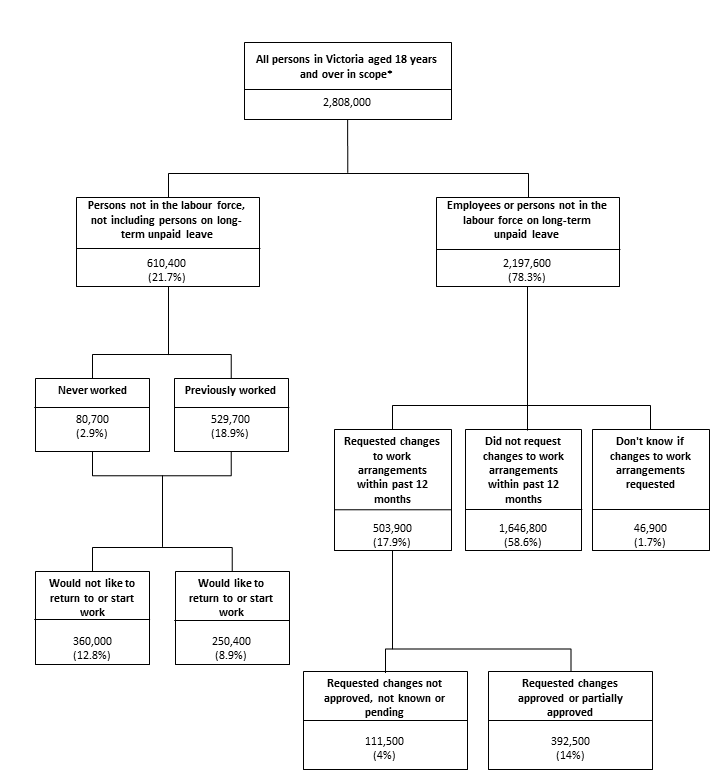EXPLANATORY NOTES
Introduction
1 This publication presents findings from the 2010 State Supplementary Survey, Workforce Participation and Workplace Flexibility. The survey was conducted throughout Victoria during the two weeks commencing 5 December 2010.
Survey Sample Design
2 The survey was conducted as a supplement to the Australian Bureau of Statistics (ABS) Monthly Population Survey (MPS). The MPS is based on a multistage area sample of private dwellings (houses, flats, etc) and a list sample of non-private dwellings (hotels, motels etc). The 2010 State Supplementary Survey was conducted using seven-eighths of the full sample of private dwellings in Victoria that were included in the MPS.
3 For details of the design, scope and coverage of the MPS, readers should refer to the Information Paper: Labour Force Survey Sample Design, 2007 (cat. no. 6269.0), and the Explanatory Notes in any recent edition of the ABS publication Labour Force, Australia (cat. no. 6202.0).
4 The Labour Force Statistical Regions used for the survey are based on the 2006 Australian Standard Geographical Classification. For further information see Chapter 5 Statistical Region Structure in the Statistical Geography Volume 1 - Australian Standard Geographical Classification (ASGC), Jul 2006 (cat. no. 1216.0). Maps of the Labour Force Statistical Regions can be seen in the Downloads Tab of this publication.
Scope
5 Information was collected via interview from any responsible adult aged 18 years and over in the household.
The following dwellings were excluded from this survey:
- unoccupied private dwellings
- non-private dwellings such as hospitals, hotels, motels and prisons
The following people were excluded from this survey:
- unemployed persons
- persons aged under 18 years
- full time students under 25 years of age
- persons 65 years and older permanently not intending to work
- people working in their own business
- people permanently unable to work
- voluntary or unpaid workers waiting to start a new job
- persons in very remote Indigenous Community Frame (ICF) collection districts (CDs).
For further information refer to
Labour Statistics: Concepts, Sources and Methods, Apr 2007 (cat. no 6102.0.55.001) Sections 18.11 and 18.13
6 The survey was conducted in both urban and rural areas throughout Victoria, and excluded people living in very remote areas who would otherwise have been within the scope of the survey. The exclusion of these people is likely to have had only a minor impact on any aggregate estimates.
Coverage
7 Coverage rules were applied to ensure that each person was associated with only one dwelling, and hence had only one chance of selection in the survey.
8 Information was sought from 3,899 households in Victoria and a full response was collected from 3,495 (89%).
Conceptual Framework
| 9 The following diagram illustrates the conceptual framework for the populations in the publication. |

* Excluded from the scope of this survey:
- unemployed persons
- persons under 18 years of age
- full time students under 25 years of age
- persons 65 years and older permanently not intending to work
- people working in their own business
- people permanently unable to work
- voluntary or unpaid workers waiting to start a new job
- persons in very remote Indigenous Community Frame (ICF) collection districts (CD) or in Special Dwellings
Note: Percentages are a proportion of the total population for all persons in Victoria aged 18 years and over in scope of the survey.
Data Collection
10 Information was collected by either a face-to-face or telephone interview, with interviews conducted over a two-week period during December 2010. One responsible adult member of each selected household was interviewed, answering questions regarding themselves and/or other persons within that household who were in scope of the survey.
Effects of rounding
11 Estimates have been rounded, and discrepancies may occur between sums of the component items and totals.
Acknowledgement
12 ABS publications draw extensively on information provided freely by individuals, businesses, governments and other organisations. Their continued cooperation is very much appreciated. Without it, the wide range of statistics published by the ABS would not be available. Information received by the ABS is treated in strict confidence as required by the
Census and Statistics Act (1905).
Related publications
13 The ABS produces a wide range of publications relating to demographic, housing, environment and transport statistics. Current publications and other products released by the ABS are available from the
Statistics page of the ABS website.
The ABS also issues a daily
Release Advice on the website which details products to be released in the week ahead.
14 The
Workforce Participation and Workplace Flexibility survey is not part of the ongoing ABS MPS program. Extreme caution must be used when comparing the 2010 survey with other related publications as differences in scope and methodology exist.
Data available on request
15 Inquiries about these statistics and more detailed statistics than those presented in the publication should be made by contacting the National Information and Referral Service on 1300 135 070 or Peter Rochester in Melbourne on (03) 9615 7411. Please see
Additional Data Available for a list of the data items collected in this survey.
 Print Page
Print Page
 Print All
Print All
 Quality Declaration
Quality Declaration